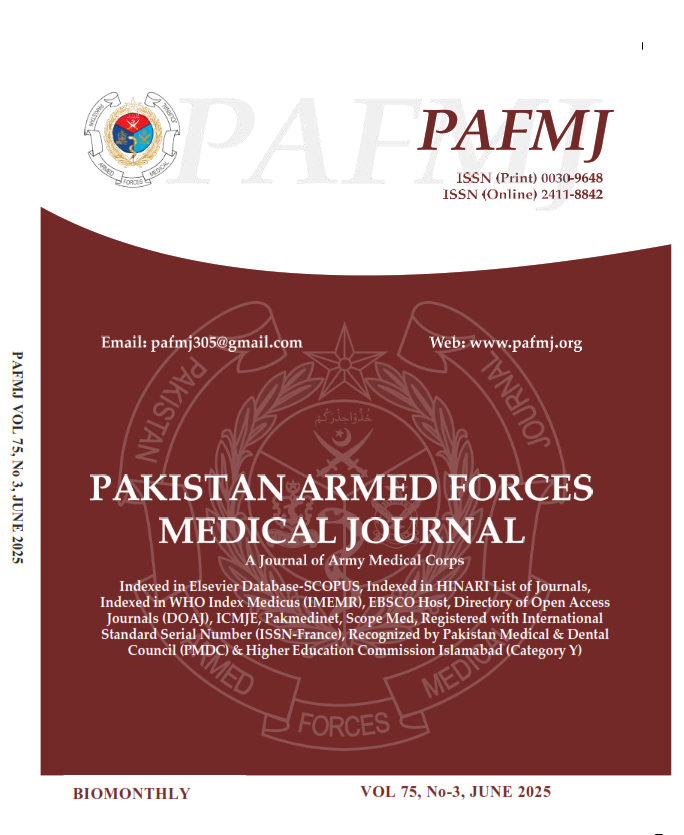Assessing Postoperative Complications in Emergency Bowel Resection and Anastomosis
DOI:
https://doi.org/10.51253/pafmj.v75i3.11709Keywords:
Acute intestinal obstruction, Bowel ischemia, Emergency Resection and anastomosis, Intestine perforation.Abstract
Objective: To evaluate postoperative Complications in Emergency Bowel Resection and Anastomosis
Study Design: Cross-sectional Analytical Study
Place and Duration of Study: General Surgical Ward, Combined Military Hospital and Pakistan Emirates Military Hospital, Rawalpindi, Pakistan, from Mar to Aug 2023.
Methodology: A total of 110 participants, both genders, who underwent emergency bowel resection and anastomosis for various diseases were selected using a non-probability consecutive sampling technique. The participants were divided into three groups, A, B, and C, according to Clavien-Dindo classification system. Data on clinical characteristics, postoperative results, intraoperative variables, and demographics were gathered and analyzed.
Results: Of the 110 patients, 79.1% (n=87) were male and 20.9% (n=23) were female. The mean age was 53.83±9.76 years. Surgical site infections (28.2%), anastomotic leaks (9.1%), post-op ileus (34.5%), and sepsis (21.8%) were among the most frequent postoperative sequelae. Group-B had the most anastomotic leak rate (18.1%), Group-C had the highest surgical site infection rate (43.4%). Group-C was predominantly affected by post-operative ileus (44.8%), and Group-B had the highest sepsis incidence (39.3%). A hospital stay of 7.3±2.7 days was average. Group-B had the greatest death rate of 24.2%, accounting for 12.7% of the total thirty-day mortality.
Conclusion: Recognizing the potential complications following an emergency intestinal resection is vital for enhancing surgical outcomes and improving patient care. By employing a multidisciplinary approach, timely detection and effective treatment of these challenges can be ensured, ultimately leading to better recovery and overall patient well-being.
Downloads
References
Barrow E, Anderson ID, Varley S, Pichel AC, Peden CJ, Saunders DI, Murray D. Current UK practice in emergency laparotomy. Ann R Coll Surg Eng 2013; 95(8): 599-603. https://doi.org/ 10.1308/rcsann.2013.95.8.599
Trompetas V. Emergency management of malignant acute left-sided colonic obstruction. Ann R Coll Surg Eng 2008; 90(3): 181-186. https://doi.org/ 10.1308/003588408X285757
Barbois, S., Arvieux, C. Principles of Emergency and Trauma Laparotomy. Textbook of Emergency General Surgery. Springer; 2023: p.815-831. https://doi.org/10.1007/978-3-031-22599-4_54.
Chua MS, Chan DK. Increased morbidity and mortality of emergency laparotomy in elderly patients. World J Surg 2020; 44(3): 711-720. https://doi.org/ 10.1007/s00268-019-05240-3
Parmar KL, Law J, Carter B, Hewitt J, Boyle JM, Casey P, et al. Frailty in older patients undergoing emergency laparotomy: results from the UK observational emergency laparotomy and frailty (ELF) study. Ann Surg 2021; 273(4): 709-718. https://doi.org/ 10.1097/SLA.0000000000003402
Vallicelli C, Coccolini F, Catena F, Ansaloni L, Montori G, Di Saverio S, et al. Small bowel emergency surgery: literature’s review. World J Emerg Surg 2011; (6): 1-8.
https://doi.org/ 10.1186/1749-7922-6-1
Wyers MC. Acute mesenteric ischemia: diagnostic approach and surgical treatment. Semin Vasc Surg 2010; 23(1): 9-20.
https://doi.org/ 10.1053/j.semvascsurg.2009.12.002
Grönroos-Korhonen MT, Koskenvuo LE, Mentula PJ, Koskensalo SK, Leppäniemi AK, Sallinen VJ. Failure to rescue after reoperation for major complications of elective and emergency colorectal surgery: a population-based multicenter cohort study. Surg 2022; 172(4): 1076-1084.
https://doi.org/ 10.1016/j.surg.2022.04.052
Alkaaki A, Al-Radi OO, Khoja A, Alnawawi A, Alnawawi A, Maghrabi A, et al. Surgical site infection following abdominal surgery: a prospective cohort study. Can J Surg 2019; 62(2): 111 https://doi.org/ 10.1503/cjs.004818
Langell JT, Mulvihill SJ. Gastrointestinal perforation and the acute abdomen. Med Clin North Am 2008; 92(3): 599-625. https://doi.org/ 10.1016/j.mcna.2007.12.004
Peters EG, Dekkers M, van Leeuwen‐Hilbers FW, Daams F, Hulsewé KW, De Jonge WJ, et al. Relation between postoperative ileus and anastomotic leakage after colorectal resection: a post hoc analysis of a prospective randomized controlled trial. CRC 2017; 19(7): 667-674.
https://doi.org/ 10.1111/codi.13582
Calin MD, Bălălău C, Popa F, Voiculescu S, Scăunașu RV. Colic anastomotic leakage risk factors. J Med life 2013; 6(4): 420-423.
Oheneh-Yeboah M. Postoperative complications after surgery for Typoid Ileal performation in adults in Kumasi. West Afr J Med 2007;26(1):32-36.
https://doi.org/ 10.4314/wajm.v26i1.28300
Rai A, Huda F, Kumar P, David LE, Chezhian S, Basu S, et al. Predictors of Postoperative Outcome in Emergency Laparotomy for Perforation Peritonitis: a Retrospective Cross-sectional Study. Arch Acad Emerg Med 2022; 10(1).
https://doi.org/10.22037/aaem.v10i1.1827
HB S. Post-operative complications rates in patients undergoing emergency laparotomy in tertiary care hospital. Asian J Med Sci 2022; 13(4): 177-181.
http://dx.doi.org/10.3126/ajms.v13i3.41152
Cellan-Jones CJ. A rapid method of treatment in perforated duodenal ulcer. Br Med J 1929; 1(3571): 1076-1077.
https://doi.org/ 10.1136/bmj.1.3571.1076
Peden CJ, Aggarwal G, Aitken RJ, Anderson ID, Bang Foss N, Cooper Z, et al. Guidelines for perioperative care for emergency laparotomy Enhanced Recovery After Surgery (ERAS) Society recommendations: part 1—preoperative: diagnosis, rapid assessment and optimization. World J Surg 2021; 45(5): 1272-1290. https://doi.org/ 10.1007/s00268-021-05994-9
Thompson K, Venkatesh B, Finfer S. Sepsis and septic shock: current approaches to management. Intern Med J 2019; 49(2): 160-170. https://doi.org/ 10.1111/imj.14199
Fang AH, Chao W, Ecker M. Review of colonic anastomotic leakage and prevention methods. J Clin Med 2020; 9(12): 4061. https://doi.org/ 10.3390/jcm9124061
Bhardwaj R, Digra NC, Singh N, Goulay J, Bhardwaj A. A Study on Risk Factors Associated with Anastomotic Leakage in Gastrointestinal Surgeries. Asian J Res Surg 2023; 6(2): 206-221. https://journalajrs.com/index.php/AJRS/article/view/158.
Skovsen AP, Burcharth J, Gögenur I, Tolstrup MB. Small bowel anastomosis in peritonitis compared to enterostomy formation: a systematic review. Eur J Trauma Emerg Surg 2023; 49(5): 2047-2055. https://doi.org/ 10.1007/s00068-022-02192-7
Downloads
Published
Issue
Section
License
Copyright (c) 2025 Fawad Anwar, Jamil Salamat Ullah, Adil Maqbool, Waleed Umer, Waseem Ahmed Khan, Shaza Bashir

This work is licensed under a Creative Commons Attribution-NonCommercial 4.0 International License.















